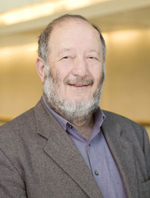October 25, 2010 - By Jonathan Rabinovitz

Irving Weissman, MD, director of the Stanford Institute for Stem Cell Biology and Regenerative Medicine, was a driving force behind the construction of the Lorry I. Lokey Stem Cell Research Building. He was recently interviewed for the medical school program, “1:2:1,” about developments in the stem cell field and how the new facility will help to advance them. The following is an edited adaptation from that conversation. To hear the full discussion, visit http://med.stanford.edu/news/all-news/one-to-one/2010/irving-weissman-on-stanfords-new-stem-cell-building.html
Q: What does this new building mean for stem cell research at Stanford?
Weissman: Well, first, it is the one place we can work together. We were fragmented all over the campus and, as you know, for the last eight years, at an off-site building, where we started testing the concepts of how people in different areas of stem cell research — cancer stem cell, adult blood-forming stem cell, brain-forming stem cell, embryonic stem cell, reprogramming — could work together and focus not only on discovery but on translation of discovery. That includes, for instance, the development of cellular therapeutics and of antibody therapeutics to molecules that we found only on cancer stem cells.
Q: How will the new building foster translational research at Stanford?
Weissman: There are 30 or so full labs there, each of which has 15 to 20 people that makes up the 550. But we’ve reserved 20 percent of the space for collaborative benches; a clinician who has a stem cell idea can come in and try it out with people who are in the lab. This sort of collaboration has already worked incredibly well for both Mike Clarke [one of the leading researchers on cancer stem cells] and me to advance our understanding of cancer and leukemia and lymphoma stem cells. In a very short time, maybe four or five years after we started, we are moving toward therapies and real clinical trials.
Q: Let me ask you about the major benefactor Lorry Lokey, the building’s namesake.
Weissman: Lorry is a fantastic philanthropist. From the word go, we didn’t have to convince him to give away his money. I mean, he was set to find a way — the best ways — to give away his money to biomedical research. So, he supports nanoparticle research in Oregon. He supports a lab in Israel that works on why proteins can be destroyed too fast in a body. But, what he had with us, essentially, was the vision that you could use the advances in stem cell biology to learn more biology, of course, but more importantly, to translate it to medicine.
While we were showing people a preview of the building, we asked Lorry to talk about it. He spoke for about 20 minutes, giving all the reasons why this is one of the two or three most important moments in his life. You have to understand that Lorry hasn’t invested in philanthropy like most billionaires — giving 10 percent, 20 or 50 percent. He’s invested a much higher percent of his net worth — about 90 percent
Q: Can you point to a relatively recent success in stem cell research that offers reason for hope for future developments in the field?
Weissman: I must say, in my own field of blood-forming stem cells, it’s moved forward slowly but clearly, and we now have shown that the experiments we did with people in the 1990s really did work to give them back cancer-free, blood-forming stem cells. And we have solidified the position that if you have taken stem cells — blood-forming stem cells — from one person and engraft them into another person, that second person is able to get any tissue stem cell from the donor.
Q: What do you foresee happening with stem cells going forward?
Weissman: We’ve just seen advances from several labs that are close to getting heart stem cells derived from embryonic stem cells. We don’t know yet whether they alone would be able to be transplanted, or if you have to put them on a manufactured matrix that you sow in as something that will begin beating right away to replace the injured heart tissue.
We now know that you can transplant brain stem cells into people safely. We know that in the animal models of human diseases they look like they can do a number of neuroregenerations, including, spectacularly, spinal cord injury in animals. And there’s just the slightest hint that they will get at diseases like cerebral palsy as well as the genetic diseases like Parkinson’s, Alzheimer’s, Huntington’s and Lou Gehrig’s disease.
And there’s the work with cancer stem cells. We’ve found that for each different cancer that there are specific cancer stem cells. We’re finding genes expressed by cancer stem cells but not by the other cells in the whole mass we call a tumor or a cancer. That’s leading to all kinds of diagnostic and therapeutic developments.
Thanks to funding from the California Institute for Regenerative Medicine, we’re seeing not only the opening of our building, but also the construction of 11 others in the state, which CIRM has helped to fund. So, I’d say, this decade of the stem cell is going to be fantastic.
About Stanford Medicine
Stanford Medicine is an integrated academic health system comprising the Stanford School of Medicine and adult and pediatric health care delivery systems. Together, they harness the full potential of biomedicine through collaborative research, education and clinical care for patients. For more information, please visit med.stanford.edu.